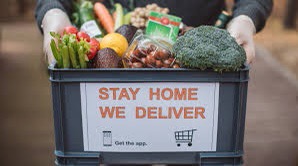The Emergence of Online Grocers
- Christopher Doyle

- Jul 17, 2021
- 2 min read
Chris Doyle
Covid-19 has changed a lot of things for Canadians. One noticeable change has occurred in the way we shop for groceries. As people began to socially-distance and governments reduced store capacity, online shopping became attractive. This was especially true for elders, people with disability, health conditions or people with COVID-19 who had to be isolated, or simply for those who didn’t want to do in person shopping.
But although some Canadians have taken to online grocery shopping, over 3x as much business is done in-person. For many individuals, the routine of shopping, online grocery delivery fees, and long-waits for delivered food are major detractors from online shopping. For its proponents, it is time efficient, convenient and contactless.
But how did online shopping begin? Long before the pandemic in 1996, Louis Borders of the San Francisco Bay area had come to a conclusion. In his view, grocery stores were “unnecessary middlemen” stuck between families and the goods they needed (Business Wire, 2020). His firm Webvan, was set to disrupt the market by being the world’s first online grocery delivery service.
(Photo: Business Insider, Webvan delivery truck in the early 2000s).
Louis’s company quickly raised $500 million from venture capitalists like Sequoia Capital, completed a successful IPO and was equipped with the latest internet technology, but went bankrupt in 2001.
The reasons for Webvan’s demise were numerous. Many believed Webvan was too ahead of its time. Observers also noted that it expanded too quickly and its price point was too high. A key liability for the firm was that it insisted on storing food in its own warehouses instead of using the infrastructure of existing grocery stores. Webvan also insisted on its own trucks. Due to these high fixed costs, Webvan booked $525 million in expenses, despite online $179 million in sales in 1999.
For many years Webvan served as a cautionary tale. After all, groceries were different from other online goods. Food is perishable and people do not want to pay delivery fees, if they can help it.
Despite Webvan’s false start, other firms are starting to prove that Mr. Borders’s dream is possible. In 2009, Aproova Mehta, a former Amazon employee, founded Instacart, a delivery service which now relies on over 40,000 established grocery stores (Instacart, 2021).
Recently, Canada’s Big Three Grocers, Empire, Loblaws and Metro, have established their own services. By 2020, 30% of all Canadian grocers, local and national, had online delivery capabilities, while spending on online groceries has reached the tens of billions (Coppola, 2021).
How successful online grocery shopping will be remains a mystery, however, the mantra of “if at first you don’t succeed, try, try again” is definitely relevant in this industry. For Louis Borders and his team, this is a moment of vindication that perhaps it was not that they had a poor idea, only poor execution. However, if these new online services are to be sustainable for customers in the long-term, they should seek to learn from customer feedback and avoid the high-costs that led Webvan to its demise.













Comments